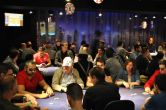Passivity Killed the Big Stack: A Spot That Called for Aggression

Covering live poker tournaments for a living affords me the opportunity to see countless thousands of hands played out, many of which offer interesting and potentially valuable insights into how players �� both amateurs and professionals �� play the game. In this ongoing series, I��ll highlight hands I��ve seen at the tournaments I��ve covered and see if we can glean anything useful from them.
The Scene
Occasionally, I get a few days off from the busy grind of watching others play poker and get to fire up a tournament myself. Just such an opportunity presented itself when the RunGood Poker Series came to Council Bluffs for a week in late August. Though I was tasked with coverage of the $675 Main Event, I did get a chance to play the $180 Deepstack.
I had come back for Day 2 with 121,000 and ran it up to about 200,000 by the time this hand transpired at blinds and antes of 3,000/6,000/1,000. As one would expect in such a small buy-in tournament, most of my opponents at the table were pretty inexperienced, and I was in a good spot at the time with all but one player covered.
It��s down to the last four tables and right on the money bubble, with 28 set to be paid and $8,704 up top plus a $2,000 package to the season-ending championship.
The Action
Action folded around to a player who had just gotten moved to the table and was on the button. Sitting with a stack of 120,000, he opened with a 2.5x raise to 15,000. The small blind folded, and I peeked down at K?7?. I called.
The dealer spread a flop of K?10?4?, and I checked. My opponent bet 16,000, and I put him all in. He snap-called, showing KxQx. The turn and river ran out dead, and I shipped more than half of my stack two seats to my right.
Concept and Analysis
My opponent makes a standard button raise in one of his first hands at the table, so I don��t yet have any reads. I look down at K?7?, a pretty solid hand considering the situation. I strongly considered shoving in this spot but opted to call instead, figuring my hand to be pretty playable postflop.
When I flop top pair, I again have a few options. After checking and watching my opponent bet, I decided to shove to see if I could get my opponent to call off light thinking I had a draw like A?X? or QxJx. That��s a play I don��t love in hindsight, but I think it could have been avoided entirely by just shipping it preflop.
There are a few reasons I like a shove before the flop better. First, I had a stack that put my opponent at risk if he called it off. On the bubble of a live tournament, even one where a min-cash is only a few hundred bucks, players are willing to call off their stacks preflop with very few hands. So it��s far more likely than not I��ll increase my stack by more than 10 percent right there.
Second, with so many more chips than my opponent, I��m not in horrible shape if he calls and wins. In that scenario, I��d have about 80,000 left, more than 13 big blinds. That��s not a ton, but it��s certainly a playable stack with plenty of fold equity even if there��s a raise in front of me.
Finally, such a play establishes a dynamic right away with a new player. If I put him all in and he folds, he may be more cautious about raising my big blind in the future, a great result if it gets me a walk or two going forward.
Despite the setback, I was still able to make it into the money, but that was as far as I got, notching a min-cash. I was left to rue this hand afterward, but at least I took something away from it.
Want to stay atop all the latest in the poker world? If so, make sure to get PokerNews updates on your social media outlets. Follow us on Twitter and find us on both Facebook and Google+!









